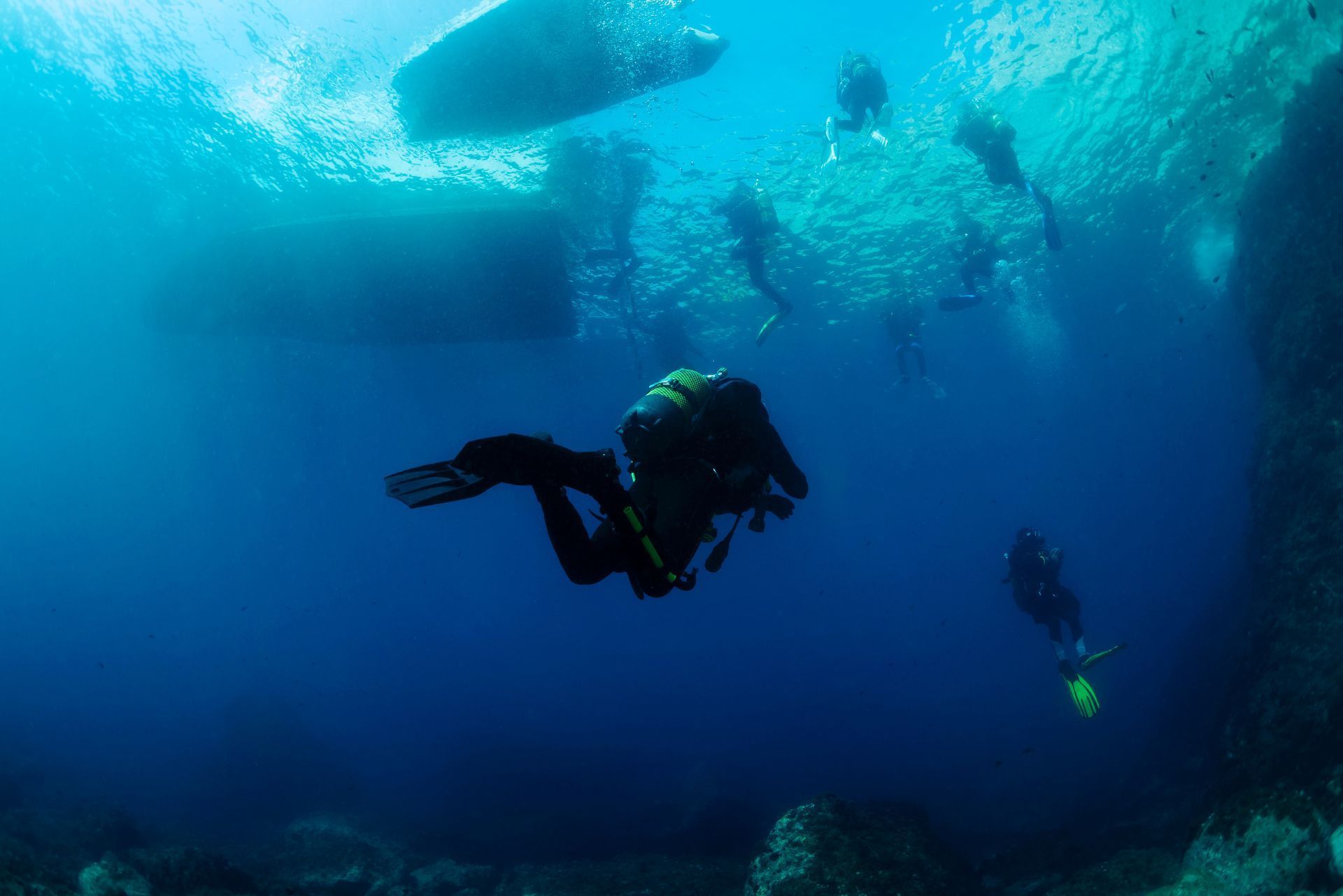Top 3 Recommended Policies

Operating a diving and underwater inspection company involves navigating a complex landscape of risks and regulations. From commercial diving projects to underwater vessel repairs, the need for comprehensive insurance coverage is paramount to protect businesses against potential liabilities and financial losses. As the global commercial diving market continues to grow, valued at approximately USD 1.5 billion in 2023 and expected to reach around USD 2.5 billion by 2032, diving companies must stay informed about the insurance products tailored to their unique operational challenges.
This article explores the essentials of insurance for diving and underwater inspection companies, highlighting key industry trends, risk factors, and how advanced technologies are shaping insurance requirements. Whether you’re a dive contractor, underwater inspector, or dive shop owner, understanding these elements will help you secure the right protection and ensure business continuity.
Understanding the Unique Risks in Diving and Underwater Inspection
Diving and underwater inspection work is inherently risky due to the challenging environments and technical complexities involved. Commercial divers face hazards such as decompression sickness, equipment failure, and unpredictable underwater conditions. Additionally, underwater inspections and repairs often require precision and adherence to strict safety standards to avoid costly errors. The underwater environment itself can be treacherous; factors such as strong currents, low visibility, and the presence of marine life can all pose significant threats to divers. Furthermore, the psychological stress of working at great depths, where the pressure is immense and the risks are palpable, can affect a diver's performance and decision-making abilities.
Insurance providers recognize these risks and offer specialized policies that cover liabilities including bodily injury, property damage, and environmental harm. For example, insurers often mandate compliance with international standards like the International Association of Classification Societies (IACS) and ISO 16638:2018 to minimize risk exposure. A 2022 study by the Norwegian Maritime Authority found that insurers rejected only 8% of underwater inspection reports when these standards were followed, compared to a 22% rejection rate for non-compliant inspections. This highlights the importance of regulatory adherence in securing favorable insurance terms and reducing claim disputes. Additionally, the implementation of advanced technologies, such as sonar imaging and autonomous underwater vehicles (AUVs), is becoming increasingly prevalent in the industry, which not only enhances safety but also improves the accuracy and reliability of inspections.
Common Insurance Coverage Types for Diving Companies
Diving companies typically require a combination of insurance policies to cover various aspects of their operations. These include:
- General Liability Insurance: Protects against third-party claims for bodily injury or property damage occurring during diving operations.
- Professional Liability Insurance: Covers errors or omissions in underwater inspections and reporting that could lead to financial loss for clients.
- Equipment Insurance: Safeguards expensive diving gear and remotely operated vehicles (ROVs) against damage or loss.
- Workers’ Compensation: Essential for covering medical expenses and lost wages if divers are injured on the job.
- Environmental Liability: Addresses potential pollution or environmental damage caused during underwater work.
Given the high stakes, many insurers also require companies to demonstrate robust safety protocols and training programs to qualify for coverage. This includes regular drills and simulations to prepare divers for emergency situations, as well as ongoing education on the latest technologies and techniques in underwater inspection. Furthermore, the integration of risk management strategies, such as thorough pre-dive briefings and the use of dive computers to monitor depth and time, is critical in mitigating potential hazards. As the industry evolves, staying ahead of these requirements not only helps ensure safety but also enhances a company's reputation and competitiveness in the market.

Impact of Technology on Insurance and Risk Management
Technological advancements are revolutionizing the diving contractor market, not only improving operational efficiency but also influencing insurance underwriting and risk assessment. The integration of artificial intelligence (AI) and machine learning (ML) enables enhanced data analysis, helping insurers and companies identify potential hazards more accurately and make informed decisions.
One notable development is the increased use of remotely operated vehicles (ROVs) equipped with machine learning-based defect detection. These technologies reduce human error, a major concern for insurers, and improve the accuracy of underwater inspections. By providing reliable, data-driven reports, companies can lower their risk profiles and potentially negotiate better insurance premiums.
Moreover, insurers are beginning to incorporate technology usage into their underwriting criteria. Companies that adopt advanced inspection tools and maintain compliance with international standards are often viewed as lower risk, which can translate into more competitive insurance rates and broader coverage options.
How Technology Enhances Safety and Compliance
Beyond risk reduction, technology also supports compliance with industry regulations. Automated data collection and analysis facilitate adherence to standards such as ISO 16638:2018, which governs underwater inspection procedures. This compliance is critical, as demonstrated by the lower rejection rates of inspection reports when such standards are followed.
For diving companies, investing in technology is not just about operational improvement—it’s a strategic move to align with insurer expectations and safeguard business reputation. Furthermore, the use of drones for aerial inspections complements underwater assessments, allowing for a comprehensive view of the worksite and ensuring that all potential risks are addressed. This multifaceted approach not only enhances safety but also fosters a culture of proactive risk management within organizations.
Additionally, the implementation of wearable technology, such as smart helmets and augmented reality (AR) systems, is gaining traction in the diving industry. These devices provide real-time data and communication capabilities, enabling divers to receive immediate feedback and guidance during operations. This not only enhances the safety of the divers but also allows for more efficient incident reporting and analysis, which is invaluable for insurers when evaluating claims and adjusting policies. As these technologies continue to evolve, they will undoubtedly play a crucial role in shaping the future of insurance and risk management in the diving sector.
Insurance Market Trends and Regional Insights
The insurance landscape for diving and underwater inspection companies is influenced by broader market dynamics and regional factors. In North America, for instance, the dive shop insurance market alone was valued at approximately USD 560 million in 2024, representing nearly 39% of the global market share. This concentration reflects the region’s extensive commercial diving activities and the maturity of its insurance sector. The robust regulatory framework and safety standards in North America further contribute to the stability of the insurance market, as companies are compelled to adhere to stringent guidelines that not only protect divers but also minimize risks for insurers.
Globally, the commercial diving market’s steady growth at a 6.1% compound annual growth rate (CAGR) underscores increasing demand for underwater services across industries such as oil and gas, maritime transport, and infrastructure maintenance. This growth drives greater insurance demand, with policies evolving to address emerging risks and technologies. Innovations such as remotely operated vehicles (ROVs) and advanced diving equipment are reshaping the landscape, prompting insurers to adapt their offerings to cover new types of liabilities and operational challenges that these technologies introduce.
Insurance Considerations for Commercial Vessel Repairs
Commercial vessel repairs constitute a significant portion of underwater diving work, with over 80% of such repairs being insurance-mandated. Insurers maintain preferred vendor lists based on extensive claims history, emphasizing the importance of reputation and proven safety records in securing contracts and insurance coverage. Companies that can demonstrate a track record of successful, safe operations are more likely to be favored by insurers, which can directly impact their ability to secure lucrative contracts in a competitive market.
For diving companies specializing in vessel repairs, this means that maintaining high standards and transparent claims processes is vital. Insurance providers closely monitor these factors when underwriting policies, often requiring detailed documentation and adherence to best practices. Additionally, the rise of digital platforms for claims management is transforming the way diving companies interact with insurers. These platforms not only streamline the claims process but also provide valuable data analytics that can help companies identify trends, improve safety protocols, and ultimately reduce their risk profiles. As the industry continues to evolve, staying ahead of these technological advancements will be crucial for companies aiming to thrive in a highly regulated environment.
Certification, Training, and Their Role in Insurance
Proper certification and training are foundational to both operational safety and insurance eligibility in the diving industry. The cost of obtaining scuba diving certification ranges from $300 to $600, representing a necessary investment for divers entering the commercial sector. This initial expense not only covers the training materials and instruction but also often includes practical sessions that equip divers with essential skills in real-world scenarios. The value of this investment is evident, as certified divers are better prepared to handle emergencies and unforeseen challenges underwater, which can be crucial in high-stakes environments.
Insurers often require proof of certification and ongoing training to ensure divers are competent and aware of safety protocols. Well-trained personnel reduce the likelihood of accidents and claims, which benefits both the company and its insurers. Moreover, companies that employ certified divers can enhance their reputation in the industry, attracting clients who prioritize safety and professionalism. This creates a competitive edge, as clients are more likely to choose businesses that demonstrate a commitment to maintaining high standards of training and safety.
Continuous Education and Risk Mitigation
Beyond initial certification, continuous education programs help divers stay updated on evolving safety standards and technological tools. This ongoing commitment to professional development is frequently viewed favorably by insurers, potentially leading to lower premiums and enhanced coverage options. For instance, many organizations offer specialized courses that focus on new diving equipment or advanced rescue techniques, ensuring that divers are not only compliant with current regulations but also equipped to utilize the latest innovations in diving technology.
Companies that prioritize training demonstrate a proactive approach to risk management, which is increasingly critical in a market where technology and regulations are rapidly advancing. Regular training sessions can also foster a culture of safety within the organization, encouraging divers to share knowledge and experiences that contribute to a collective understanding of best practices. Additionally, many insurers recognize that a well-trained workforce can lead to fewer incidents, which ultimately translates to lower costs for both the insurer and the insured. By investing in continuous education, companies can not only safeguard their employees but also enhance their operational efficiency and overall profitability.

Conclusion: Securing the Right Insurance for Diving Companies
Insurance for diving and underwater inspection companies is a multifaceted necessity shaped by operational risks, technological integration, and regulatory compliance. As the commercial diving market expands and innovations like AI-driven ROVs become standard, insurance products are evolving to meet these new challenges.
Companies that invest in safety, technology, and certification not only protect their workforce and assets but also position themselves favorably with insurers. This strategic approach can lead to more comprehensive coverage, reduced premiums, and stronger business resilience.
For diving professionals seeking to navigate the complexities of insurance, staying informed about market trends and regulatory requirements is essential. Leveraging insights from industry reports and studies, such as those from
DataIntelo and
PMarketResearch, can provide valuable guidance in securing the right protection for long-term success.
Contact Us
Phone
Location
9595 Six Pines Dr, Suite 8210, The Woodlands, TX 77380

